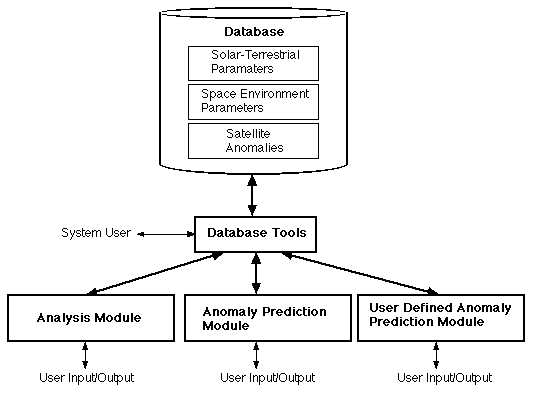Spacecraft Anomaly Analysis and Prediction System - SAAPS
The project will result in the development of the Spacecraft Anomaly Analysis
and Prediction System (SAAPS). The components of SAAPS are illustrated
in the figure below and will consist of
-
the data base and the data base tools,
-
the analysis module, and
-
the prediction module.

Data base and data base tools
The data base will be developed with the users in mind. This includes the
identification of spacecraft operators that are interested and willing
to put their anomaly data into the data base. The data base will first
be set up at IRF-STL and at the end of the contract be delivered to a server
at ESTEC. The tools will be implemented in HTML and Java code to be accessible
through a web browser. Privileged users will be able to add new satellite
anomaly data to the data base. This is important to keep the data base
up to date. Others can either operate the software to analyse their data
base and submit a request for permanently include their data set.
Solar-terrestrial data, such as solar wind data and magnetospheric indices,
will also be included in this study. The data base tools will enable access
to the data that are publicly available on the internet, such as the different
world data centres, OMNI data base, and ACE solar wind data.
Anomaly analysis module
Based on the data in the data base it is possible to analyse the probable
cause of the anomalies. From a Web browser the user will be able to apply
the anomaly analysis module on the data base. Functions that should be
included are calculations of correlations between different parameters
and superposed epoch analysis. It should also be possible to define different
selection criteria like anomaly type, local time, geographical position,
time of year, and so on. The results will be either graphical output or
tables.
Anomaly prediction module
Finally real time predictions will be made with the developed AI models
based on different solar-terrestrial parameters and space environment data.
A preliminary model for the prediction of spacecraft anomalies based on
Kp (Wu et al., 1998) will be available early in the project. During the
project the prediction module will then be extended to include more of
the space weather parameters, and a second prototype will be available
during 1999.
The extended data base will make it possible to further explore the
relation between non-local environment data, such as Kp or solar wind data.
The inclusion of more satellites will improve the model estimation, e.g.
the training of the neural networks, and it will put higher confidence
on the statistics of the model testing.
As the space environment is a region of many different sources and particles
a satellite anomaly index (SAI) could serve as a useful parameter to the
spacecraft operators and other users. The SAI will be available in real
time and might be composed of several indices which take into account different
effects and use different input parameters.
Initially the SAI will be a general index in the sense that the model
that calculates the index is developed from this project. The aim is that
in the prediction module there will also be a dedicated user defined model
that can be trained on data that the user specifies. This will enable the
user to have a dedicated satellite anomaly index to predict anomalies for
e.g. one specific satellite or a selection of satellites.
To complement the analysis module it will be examined if models similar
to the SAI predictions can be developed to make predictions of the charged
particle environment at geosynchronous orbit from solar wind data and magnetospheric
indices. Such predictions will help in the understanding of the predicted
anomalies.
Implementation for real-time predictions
The final product from this study should be a working system for real-time
analysis and predictions of satellite anomalies. The predictions are to
be made on two time scales: hours in advance, and days in advance. The
daily predictions are of lower confidence and possibly summarised in a
single SAI. The hourly predictions will give a more detailed picture of
the space environment. The program will automatically collect the relevant
data, make appropriate normalisation and feed it into the models for predictions.
The results will be formatted so that the predictions can be viewed using
a Web browser.
